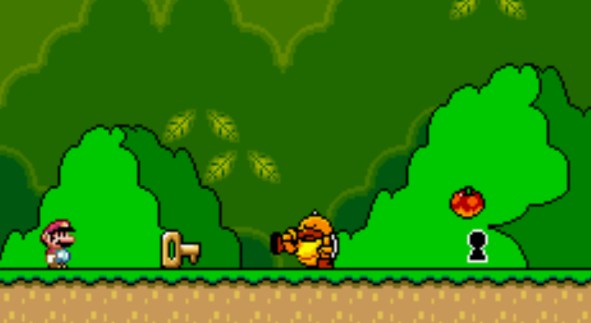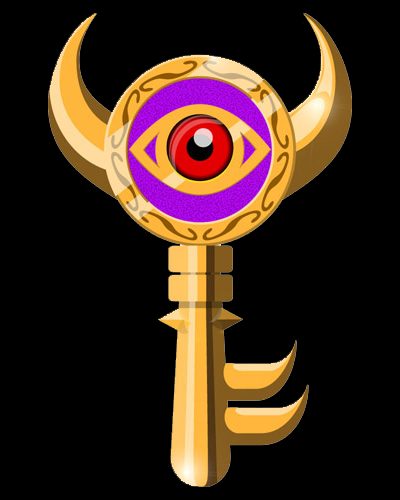Locks, Keys, & Obstacles pt.1
 Saturday, November 7, 2009 at 2:45PM
Saturday, November 7, 2009 at 2:45PM part.1 part.2
Video games are built upon the foundation of interactivity and challenges. The game throws a number of challenges in your way somewhere between the start of the game and the end, and you're expected to be able to overcome most if not all of the challenges. For games that are very linear, to progress to the next level one must get to the end of the current one. In this way, each level functions as an obstacle that's like a lock. And the key to this lock is a combination of basic player mechanics and player skill. They key is execution. The key is the journey.

For more open games that don't have a simple level progression structure, keys and locks are put to use. Locks temporarily prevent you from accessing and area. Once you get the key, then you can continue. When used poorly, locks & keys can "artificially" extend the play time of a game by forcing the player to "jump through hoops." When used well, locks help create challenges that shape a rich journey. Before we continue, we need definitions.
Obstacle: A general term for any challenge in a game that the player can only overcome by using mechanics.
Lock: Any object/system that restricts player progression or prevents access to an object/area. All locks must be able to be opened with a key. Locks can be in a locked, temporarily unlocked, or permanently unlocked state.
Key: Any object or system that can be used to open a lock.
Pin: Any procedure or steps involved in using a key to open a lock.
Let's consider the different types of locks. Locks come in all shapes and sizes from gates, to portals, to NPC that just won't let you pass. In fact, a ledge that's just out of reach can be a lock preventing you from accessing a higher area. In this case, as long as you can eventually reach that higher area by, let's say, stepping on a switch (the key), then the ledge can be considered a lock.

LOCKS
Let's go over the different types of locks:
- Strict/Linear Lock: These locks are hard coded to only open after a single key is used in a specific way. Just try getting into the key hole in Super Mario World without the Key.
- Organic lock: These locks are much more lenient than strict locks. Organic locks are created out of game rules and game dynamics. Because dynamics foster emergence, multiple solutions are also probable. For example, if you need a certain amount of weight on a switch to unlock a gate, for an organic lock it's possible to use a variety of game objects as a weight. In LittleBigPlanet, all the objects in a level have weight and physicality to them. To weigh down a switch you can jump on it, get you and 3 of your friends to stand on the switch, drag an object over to the switch, push down on the switch using a jetpack, or even flip the switch upside down so it weighs down on itself.
- Or-locks: A lock that can be opened with any key of a specific type or a range of types. The locked doors in many Zelda dungeons are or locks. This means you can use any small key you find to open any of these locked doors.
- And-lock: Some locks require multiple keys to open. If the player doesn't have all the pieces, nothing happens. If you've ever collected 3 pendants, 7 crystals, or any other number of special items to progress in a game, you've experienced an and-lock.

KEYS
Locks are just half of the equation. Keys are the more interesting and versatile part of the set.
- Abstract key: These keys are usually an item that merely takes up a space in your inventory. The game tells you that you picked up a key, and afterwards certain lock will be opened for you. You can't do anything else with the key outside of picking it up and opening a lock. Abstract keys are also found in situations when players have to do a specific action before they can progress to the next scene.
- Reusable keys: These keys aren't consumed when used for the first time. Some keys have limited use. Some can be reused over and over.
- Versatile key: Some keys can actually open multiple locks. For these keys, it makes a big difference whether or not the key is reusable. If not, the player may be faced with a difficult choice; to open door number 1 or door number 2.
- Core Mechanic key: For these locks, the player's core mechanics are the keys. Just JUMP, GRAB, SHOOT, PUNCH, etc in the right place, with the right timing, and/or in the right way and you're in.
- Upgrade/Powerup key: Like core mechanic keys, some locks are opened with optional or upgraded abilities. Examples include using super bombs to access new areas (Super Metroid), hookshotting to new spots (Zelda), and the tiny warp pipes in New Super Mario Brothers. The first time you run into these locks, you may or may not have the mechanics necessary to progress.
- Organic/Dynamic key: The opposite of abstract keys, these keys are an organic part of the game world. Depending on what dynamics a game is designed with, organic keys play by the same rules. The keys in Super Mario World, some in LittleBigPlanet, and many of the keys in The Legend of Zelda:Phantom Hourglass are organic keys. This means to get them from one place to another, they can't simply be stashed away in an item menu. They must be pushed, picked up, or otherwise moved from point A to point B. Organic keys can turn a basic fetch quest into a dynamic challenge. From simple level design to the much more advanced folded level design.
Overcoming locked obstacles can easily take up the majority of a game like The Legend of Zelda. A dungeon is essentially a series of locked rooms. Some locks are opened with little silver keys. Others by hitting switches with special weapons. And others still by killing enemies. The Zelda series provides prime examples of how to integrate lock & key design into the core dynamics and gameplay.
In the next article, I'll go over several examples of locks & keys from The Legend of Zelda: Twilight Princess. Believe me. Locks are the key to understanding Zelda's dungeon design.


Reader Comments (5)
SP error in the first paragraph: "They key is execution."
I think that the artificial extension of gameplay is trying to get you to complete the same challenges multiple times. Defeating the same enemies in the same locations gets repetitive and boring.
You introduce obstacles at the beginning, but never discuss them. They seem similar to Organic Locks in that they are cleared using game mechanics.
@ Bryan Rosander
All locks are obstacles. But not all obstacles are locks.
The critical difference is that if there's no key, there's no lock. So, a tall pipe that's in your way in Super Mario Brothers is an obstacle. To overcome the obstacle, just jump over it. BUT, if that pipe is too tall to jump over and there's some kind of switch you can ground pound to lower the height of the pipe, THEN it's a lock.
So, if games are filled with challenges, then they're filled with obstacles. I just defined it upfront so I could make the distinction between locks, keys, and obstacles.
As far as the artificial extensions are concerned, there's not an exact factor you can look for. We determine how artificial a game's content is by feel. You're right, doing the same challenge or even a slightly different challenge repeatedly is not very good design in my book.
The confusion is over the definition of keys then. You call "core mechanics" a key, and even include running and jumping. But that is the key to get past the pipe.
For consistency, I would clarify that there needs to be something a little more advanced for core mechanics and obstacles so that not every single obstacle and enemy is a lock.
@ Bryan
I didn't call "core mechanics" a key. I named a type of key... "core mechanics keys."
Try not to get tangled up in the language. Running and Jumping may be necessary to overcome many of a Mario's games obstacles, but that doesn't mean doing so is using keys or unlocking locks.
A key is not a possible solution. A key is a mechanism. We use keys to change the state of a lock. A lock must be a structure/system that restricts progression (or prevents access). A key must open a lock. And a lock must have locked and unlocked states.
I'll try tweaking the definitions a bit.
The updates to the Core Mechanic Keys definition helps a lot.